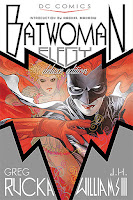 |
| Cover by J.H. Williams III |
Batwoman: Elegy (2010)
Writer: Greg Rucka
Penciller: J.H. Williams III
Colorist: Dave Stewart
Letterer: Todd Klein
Batwoman: Elegy has a reputation of being pretty damn brilliant. After seeing many in the comic book community praise it, I knew I had to check it out. Of course, all I knew about Batwoman was that she was only created to help dispel rumors of homosexual subtext between Batman and Robin in the early half of Batman’s comic book career. So really, I had absolutely no background in just who Batwoman is: her history, her connection to Bruce Wayne or even her real identity. This probably accounts for my extreme confusion while reading this graphic novel.
The novel follows the rather devil-may-care Batwoman as she investigates the reappearance of thirteen covens of some religion of crime. These covens have a new leader and she wants to know who they are and what they are up to. Already I was thrown by this. What covens in Gotham? This is a thing? I had no idea.
We then meet this new leader: Alice, a gothic, colorful crazy person who fancies herself a living Alice in Wonderland character and considers everyone around her completely expendable. She speaks fancifully, dresses ornately and has rather kabuki make-up. She reminded me of something out of an Alan Moore comic actually rather than someone I would find in a Batman comic. I’m not sure why. Though her true identity is explained away in a surprising twist midway through the novel, the fact that she modeled herself after Alice in Wonderland bothered me. As Batwoman pointed out, Gotham already has a Lewis Carroll villain with the Mad Hatter and my extreme dislike of him prejudiced me against Alice.
What was particularly interesting about this comic was Rucka’s narrative style. The plot did not at all follow the typical comic book narrative pattern and I was pleasantly surprised by that. For example, the villain was disposed of halfway through the comic, which is essentially unheard of. Furthermore, the entire second half was concerned solely on Batwoman’s personal memories. Her life story is quite different than other comic book heroes and definitely intriguing. Of course, she still had that traumatic childhood moment that most heroes have but Batwoman was also a military brat, trained as a cadet and then, after being outed, chose to abandon her military career rather than lie about her identity as a lesbian.
My favorite aspect about her personality was her reasoning behind her desire to serve Gotham as a vigilante. She refers to the Bat-signal as “a call to arms”, which for me, was a completely new way to view this well-known aspect of the Batman mythos. I quite liked this and it reminded me of how inspiring Batman can be. After reading so many “meh” comics, I always forget how one of the main appeals of comic book heroes is how they can inspire others.
Something I decidedly did not enjoy and also did not fully understand was the subplot of the occult in this comic. I always dislike supernatural elements in Batman comics because they just don’t fit in Gotham City. Batman is realistic, damn it! He has no tolerance for werewolves and witches and octopus-men (there was an octopus-man in this comic. I was confused) and neither do I.
Plot-wise, the comic didn’t do anything for me. Batwoman, who as a lesbian is one of the few mainstream queer comic book characters, can be a very dynamic and interesting character. Unfortunately, I found her rather flat in this comic. She seemed to be more comprised of stereotypes than anything else. She very much felt like what a man thinks a lesbian must be like rather than an engaging character that just happens to be gay. I don’t know, I was rather disappointed. I know the inclusion of Batwoman’s sexuality has been met with both praise and criticism, and while I admire DC’s attempt at diversity, it definitely felt contrived.
Now, onto the aspect of the comic that definitely makes it worth reading. The art by Williams III was breathtakingly beautiful. I loved it. After reading the comic, I often found myself opening it back up again just to look at my favorite panels and pages. I was blown away by the multi-layered intricate details within each page, often spread out across a double-page. I know I probably still missed things in each page because of how extremely detailed they all were. Furthermore, Stewart’s use of color was very vibrant and beautiful. His use of red was particularly interesting, especially when juxtaposed against the muted grays of Gotham City. Overall, I would definitely recommend picking up Batwoman: Elegy if only to take in Williams III’s amazing art.
No comments:
Post a Comment